AIShub, how you too can put AIS targets online
At the end of Wednesday’s discussion about cell-based mAIS — which only works via the Internet instead of direct VHF radio transmissions — I mentioned how I’d set up a real AIS receiver in my lab to forward real AIS target info to those same Internet services. In fact most all the actual AIS targets shown in those screen shots came through my basement. The set up turned out to be very easy and cost nothing as I already had an AIS receiver, a computer, and an Internet connection. The key is the free program AISdispatcher seen in the foreground above, which is offered by AIS Hub data sharing center. That’s their Web site in the background, showing the data I’m contributing along with that of other volunteer stations. But there are lots of holes in the coverage and I’m hoping that more coastal residents and particularly marine businesses will volunteer, and I think that the new mAIS concept could make the effort especially worthwhile…
But before theorize about the brave new world of mAIS and AIS on the Internet, I’ll explain more about AIS Dispatcher and my lab setup. The status screen below left shows approximately a full day’s output, which goes to AIS Hub, MarineTraffic, and ShipFinder without any more setup than registering with AIS Hub. Note the Output Bandwidth use of 0.004 KB/s; my location and antenna situation, and the season, results in a paltry average target count of about 3, but you could “dispatch” hundreds of targets without denting your Internet connection.
I also like how AIS Dispatcher parses the NMEA 0183 VDM strings and counts the individual AIS messages they contain. For instance, the ratio of Class B dynamic and static data messages — #18 and #24 — jibes with the reality that the one Class B I’ve been seeing is mostly tied up at Wayfarer Marine; since message 24 is fixed at six minute intervals, most of the time the boat was sending #18 messages at the under 3 knot rate of every three minutes. To better understand what those message counts mean see the USCG NavCen’s message detail and this Panbo about Class A & B dynamic data rates.
But I digress. While I think it’s good for boaters to understand how the AIS works, it’s not necessary for setting up an AIS listening station. Aside from registering with AIS Hub I only had to tell AISdispatcher which com port the receiver was on (as seen below right), type in the output address they emailed me, and that was it. Well, I also set up GpsGate Express — the green icon lower right and another freebie — so that I can still access the AIS receiver with other software, but that too just took minutes, not hours…
It also happens that my AIS receiver doesn’t have USB output and the computer doesn’t have an old style serial input but a Keyspan 19HS adapter takes care of that issue. And today there are AIS receivers with USB output, like the Comar AIS-2-USB, and even receivers designed for dispatching without having to leave a computer running, like the Digital Yacht AISNet Base Station, which I wrote about in 2010. There’s a good run down on all this at Marine Traffic, which also has its own free dispatcher software.
These online AIS services also have sophisticated monitoring of their volunteer stations, as you can see by turning on More/Stations on MarineTraffic’s Live Map or going to this AIS Hub page. In either case you can get a graph of a station’s performance and much more. Thus you can see how paltry my feed is, which is due to the season — no visiting yachts yet — and especially to my poor antenna and antenna location. But all this is really just an experiment with one goal being to persuade some locals with better locations and even more motivation to become volunteer AIS stations…
Like how about Wayfarer Marine? Note how their site already offers an online weather station, which appears in more detail as a Weather Underground Station (and was set up largely by Panbot Allan Seymour of the good tug Sally W). That station is great for locals and Wayfarer customers and probably especially staff who are home but worried about what’s happening at the yard during storms. An AIS receiver would co-habitat nicely and easily with the dock house PC that’s hosting the weather station and I think that many customers, not to mention me, would like to see their AIS-equipped vessel online when it’s in the area. Wayfarer could even put up a ShipFinder or MarineTraffic widget like I’m testing at the bottom of the Panbo About page.
Now think about how mAIS might fit in. Customers, visitors, and locals without regular AIS could also show up on the Web widget, iPad apps, etc. Wayfarer staff delivering boats down the coast could be monitored on the same office screen as real AIS targets. Remember that mAIS doesn’t need a shore receiver to be seen online, just a cell connection. And when the Penobscot Bay Regatta fires up in August, all the sail races and powerboat cruises off Camden could be tracked as long as the vessel has a real AIS or a smartphone running mAIS. Ships and ferries too, though they will not be bothered by the mAIS unless they choose to look. (By the way, I’m going to be the “powerboat guide” for this year’s PBR; more on that soon, but do consider signing up.)
Yesterday I got an email asking about setting up an AIS shore station from Captain Ethan Maass of Sea Tow South Shore and it seems to me that there’s tons of useful and just plain interesting information the combination of mAIS and an AIS shore station can provide his customers and community, and his business. Heck, I wonder if SeaTow won’t eventually add mAIS tracking and online AIS viewing to its already useful app. I know it’s confusing, but obviously I’m enthused about the possibilities here.
And, by the way, there can’t be too many shore stations. As this map showing the output of one AIS Hub station in Seattle shows, the servers can see and handle duplicate target reports. If you have a good antenna view toward navigable water, and especially if you’re a marine business, please consider joining the global and publicly available AIS listening network.


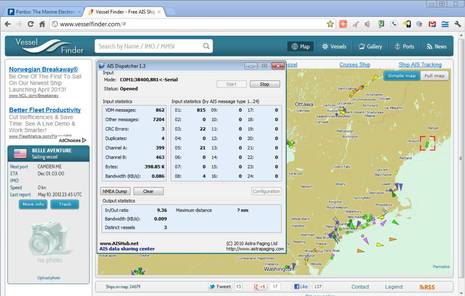
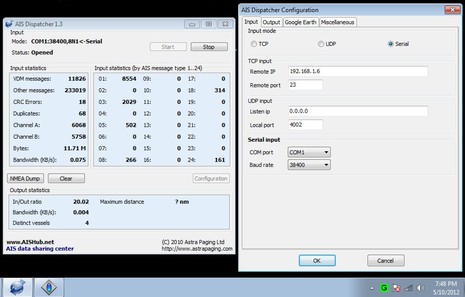

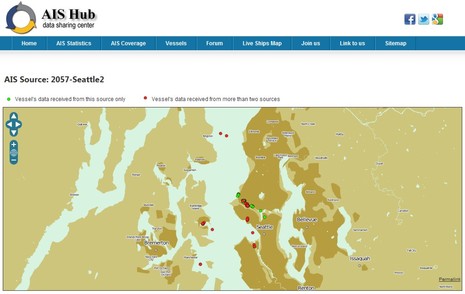
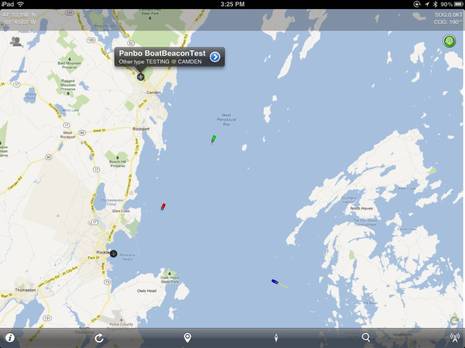
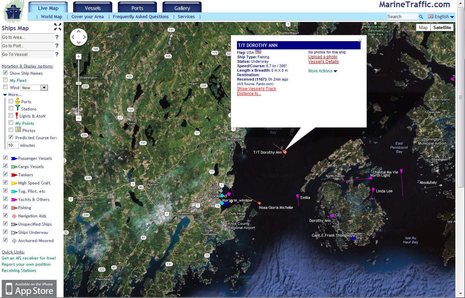








As poor as my antenna and location are, I am seeing Acadian 20 miles down the Bay:
http://shipfinder.co/ship/316012950
Yes, AIS Hub is a good outfit. If you contribute your AIS feed, you can get the NMEA feed from their global network via a TCP/IP port. This comes in handy if you are developing AIS tools. For example, while I was waiting for the U.S. approval of Class-B transponders, I had access to data from Europe, allowing me to test NavMonPc with live Class-B messages.
I’ve been an AIS Hub station for several years now (I’m “San Francisco”). My best range is a bit over 2000 nautical miles, but generally I only receive out to 100 miles or so. The antenna is at 1000 ft overlooking the ocean, with some hills blocking the signals from the north.
Thanks, Paul. I can see from the AIS Hub stats that you’ve been a pretty faithful contributor. I also see that both your station and Monterey are now tracking a ship called TAIO DREAM that’s nearly at the latitude of Cabo San Lucas and maybe a fifth of the way to Hawaii.
Wow. What sort of antenna and receiver are you using? Or is that some sort of ducting phenomenon?
Ben, interesting stuff. Wouldn’t it be possible for any vessel with an installed AIS and onboard computer, with the ability to connect to shore-based Wifi networks, to act as a “Hub Station”? I can see great possibilities for extending the AIS coverage to remote areas without land-based AIS stations, but WITH wifi capability and plenty of visiting vessels. Of course, the AIS output on the boat would have to be “split” to a port on the PC, if it is currently connected to another display or device…
Ben,
I’m one of the other Seattle guys and have been sharing for just about a year now. My set up early on was similar to what you are running currently in your lab. After a while though, I got tired of needing to maintain the service on my constantly changing pc. I had a few wired network serial device servers I’d picked up on ebay to do some 0183 work on my boat, and thought I’d try UDP-ing the sentences in to AIShub directly with one. Bingo, it worked perfectly! now I have a robust connection that recovers quickly following power or network outages.
Receiver: Icom MXA 5000
Serial server: Quatech qse-100
Thanks for the mention and thanks for the coverage of Penobscot Bay.
Everybody around should thank you as well. Now we can see more of what is happening our little busy body of water. Even the Maine ferries have gotten into the act!
Ben, I’ve got a plain-vanilla AIS setup: A marine VHF tall whip on top of the barn feeding a SR-161 (single-channel) AIS receiver. The receiver serial port is connected to a RS-232 / Ethernet adaptor, then to an old netbook that connects to the AIS Hub server. I actually feed several servers, not just AIS Hub, and get their feeds for my own use in return.
The DX reception is due to tropospheric ducting, and at 1000 ft elevation we are well-situated at the marine-layer (fog) boundary. The range all depends on the weather. On clear days we see out just past the horizon, but when the conditions favor ducting we often have coverage to the tip of Baja California (and occasionally halfway to Hawaii).
On my boat I have a Class-B transponder, with the antenna on the upper spreader. We usually receive out to the horizon, or a little bit farther, but on some days we receive 200+ miles. I assume our transmit range is somewhat less, due to our low-power Class-B signal. As far as I’m concerned, anything beyond six miles is just gravy.
Thanks Ben for promoting AISHub 🙂
Happy to report that AIShub ran for about two weeks straight without a problem. I stopped it briefly this weekend to try out an Em-Trak R100 AIS receiver, which worked very nicely and was super easy to set up because it can both get power and deliver data via USB. Windows 7 found its drivers too (and it comes with CD of drivers for other operating systems). And it’s only $220 at West Marine:
http://goo.gl/uJ2xV
Unfortunately my antenna location has gotten worse as the tall trees around my house have fully leaved out, especially when it’s raining hard like it is now. Hopefully the R100 will soon be operating from a better site overlooking Penobscot Bay.
I have my AISNet Base Station up and running now and have filled a gap in coverage for MarineTraffic.com here in Cape Cod Bay. Very happy with the AISNet and it was extremely easy to setup.
Thanks for the guidance Ben!
That’s great, Ethan. Did you know that if you enable More/Stations on the top left of Marine Traffic you can see all sorts of stats for “Sea Tow South Shore” like the fact you’re covering some 1,700 square kilometers?
http://www.marinetraffic.com/ais/stationdetails.aspx?station_id=551&header=true
I ran into Wayfarer’s dockmaster this morning and he whipped out his iPhone to show me how he was tracking Belle Adventure up the Bay via my little receiving station (stats at AISHub but showing on Marine Traffic too). Thus he knew just when he needed to clear some dock space, and when he’d see his girlfriend 😉
I really don’t know why I didn’t try this sooner or why more businesses like yours don’t set up a station.
Oops, a Google “expert” is wrong when he claims that public AIS tracking is better than what the Navy, Coast Guard, etc. are doing. Anyone surprised?
http://goo.gl/H18gt
Cool. If you go to MarineTraffic, enable “More/Stations”, and click on the Camden one, you’ll see that it’s Panbo.com with receive statistics, etc. It turned out to be easy to register at Marine Traffic and get a unique port address that I could add to AISdispatcher.
You may also see a station in Rockland that’s actually onboard the yacht Knickerbocker. I haven’t seen this before but if you have AIS going to an onboard computer that’s also online, it’s quite easy to be a moving AIS-to-Web receiving station. Very cool, I think.
My brother-in-law reports seeing over 100 AIS targets in the Newport, RI, area yesterday via his Class B responder. But only a small fraction of those show up on Marine Traffic and other public online AIS sites.
Why? Because so few marine businesses and boaters who live near the coasts have set up volunteer receivers, even though it’s pretty easy and inexpensive. Please do it!
Ben asked me to post a description of my AIS receiving station, so here goes:
My little boat lies in a marina some 10 miles from my house and, after installing a class B transponder in the boat, I tought it would be nice to be able to see it on VesselFinder and MarineTraffic. Added bonus was that, as a contributor, you get full access to all other submitted data for free !
I’m landlocked but near the rivers Waal and Maas, they have substantial cargo traffic. Also my part of the country was a blind spot at the time, although that has changed the last 2 years.
The antenna, receiver and server are all in the attic under the roof (will come back on that later), and the link to my router and modem is by WiFi extender dedicated to the server.
Before describing the parts of the station here’s a diagram of it:
http://www.starrenburg.eu/AIS_Rx_diagram.jpg
BTW: ‘station’ is a big word for a bit of 9″ x 9″ ply with 2 little boxes on it 😉
The antenna is a double stack of 5/8 wavelength antenna’s, a Diamond BC162, with the aid of an enclosed diagram you can tune it to 162Mhz. Aircell7 coax feeds the signal into an Advansea 2 channel AIS Rx-100 receiver. Output from the receiver is NMEA0183 at 38.400 baud, this goes by simple Rx Tx and Gnd wire to the serial port of the Netcom-111 server.
The ethernet link is via TP-Link WiFi extender to my router and modem located on the groundfloor of the house.
I found MarineTraffic most helpfull and very quick in answering my questions, I got a ‘personal’ port and IP adress to send my data to.
First I sent via TCP Raw Client, but after some months MarineTraffic developed a stack error in their system so I changed over to UDP and stayed there ever since. MarineTraffic forwards my data to AISHub so I didn’t spent any time figuring out how to do so myself 😉 Looking at the current situation in Greece I do hope they will be able to stay online …
As for the location: my house isn’t situated perfect and of poor heigth antenna wise. Also beeing under the roof doesn’t help. I hope to hear in the near future if I can move the station to a good location, if that fails I will put up a small mast to get the antenna over the roof at the maximum heigth allowed by local building code.
Either way you should see an increase in ‘seen’ ships at my statistic pages:
http://www.aishub.net/aisgraph.html?rrdname=2201&sname=Nistelrode
http://www.marinetraffic.com/nl/ais/details/stations/1753/
I hope my little story might be usefull to you,
w fr greetings, Leo
PS: you might see some dips in the number of ships this week or so.
I’m testing my APRS, the radio amateur version of AIS, setup on 144.800MHz for PA5LS-8, using 10W output near the AIS Rx antenna:
http://nl.aprs.fi/info/a/PA5LS-8
Oops, found a typo: the antenna is a Diamond BC102, not -106.
Besides that one I have just tuned a Diamond F23 to 162MHZ, this one has a bit more gain (and length) than the BC102.
An overview of the antennas:
http://www.diamond-ant.co.jp/english/commercial/com_3fix.html
w fr greetings, Leo
Thanks, Leo; great stuff!
But I’d appreciate more information on how you set up the Netcom-111 server to upload the AIS target data to Marine Traffic using either TCP or UDP. Keeping a PC running is my main impediment to maintaining a consistent volunteer listening station like yours, and I’m sure I’m not the only one.
However, Netcom gear is not available in the U.S. though similar seeming Serial RS232/422 to Ethernet servers are. And if not already obvious, I am not much of an IT person, so I’m shopping with caution.
Was it simply a matter of going the Netcom’s browser configuration and entering your MT assigned IP and port address into the TCP or UDP Client Mode settings? If you have the time, do you think this inexpensive server will do the trick:
http://www.atc-converters.eu/atc-1000-p-4981.html
The 111 is in stock and sells for $128 in Canada:
http://www.electronicnetwork.ca/en/netcom-111.html
If that’s Canadian dollars that would make it just over US$100, a steal 😉
I’m on and in the river right now, local temperature is around 100F and will rise to 110F over the weekend. When it’s cooled down a wee bit this night I’ll make a couple of screenshots of the 111 settings, it’s real easy to configure once you know how 😉
As for the ATC-1000, from the specs it would do the job IMHO, but I can’t see the price(login).
w fr greetings, Leo
$56 at Amazon…
http://www.amazon.com/gp/product/B00ATV2DX2/ref=ox_sc_act_title_1?ie=UTF8&psc=1&smid=A1UO2GJ291VXKR
…maybe too inexpensive?
¡ WOW ! $56 is a very neat price, and there no such thing as too inexpensive for me, remember I’m Dutch 😉
As for the Netcom 111 configuration: I made a couple of screenshots, the 111 has it’s own webpage to configure and check it. Best to right-click on a link to open the picture in a new tab.
http://www.starrenburg.eu/111_1.JPG
On this page I set the name (any to your fancy) for the server and enable DHCP.
http://www.starrenburg.eu/111_2.JPG
You could set a password here if you like, and set the timezone. I opted to let NIST set the time at startup of the server.
http://www.starrenburg.eu/111_3.JPG
This is where the important stuff happens:
set the 232 port to 38.400 baud and set the flowcontrol to the values you see here.
The transfer settings use the values given to you by AISHub or MarineTraffic, it’s an IP address and a port number, they make up your destination ie. where your data is sent to. The mode here is UDP, TCP Raw Client is a more secure way of sending and checking data, but that led to some problems at the receiving end so I switched to UDP, that is “send and forget” but it works OK 😉
http://www.starrenburg.eu/111_4.JPG
On the Tools page you can check the data from the Rx as seen by the 232 port
http://www.starrenburg.eu/111_5.JPG
This is the UDP connection set by the server.
That’s about all ! I’m certainly no network specialist and it took some reading of the manual that comes with the Netcom 111. Another make of server might be somewhat different in look, but it will need the same data to be configured in order to work.
Hope this helps a wee bit,
w fr greetings, Leo
Perhaps good to mention here:
Both AISHub and MarineTraffic have a ‘generic’ IP address and port nummber where you can send data to, but then you don’t have your own station number and the statistics that they prepare for you. So IMHO it pays to get a personal address, its very easy to get from them through their webpages.
Did I mention it’s free of charge and you get free access to ALL ie. worldwide data for free when you send in your AIS data ?
w fr greetings, Leo
I’ve had good results using Lantronix UDS-100 device servers at two receiving stations. Both trouble-free for nearly two years. I got mine off ebay.
Thanks, Mark. The Lantronix UDS100 was discontinued in 2007 but there are still lots of them available on eBay. I’d prefer one with just a terminal block for the serial connection, and may try the ATC or similar. Still researching…
And thanks again, Leo, I’m slowly getting the picture of how these things set up 😉
I realise this is an old post but what was the additional software you used to share access of your AIS receiver between multiple software?
I see AIS Dispatcher has a TCP server option but no real documentation on how to use it.
I know I’m resurrecting a 10-year-old post, but it seems appropriate. I want to do exactly what you are doing Ben, but I don’t want to run a PC. Are you aware of any Android solutions? Whenever I am on the boat, my Android is connected to my AIS and usually to a cell signal.